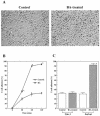Role of cell-cell communication in inhibiting butyric acid-induced T-cell apoptosis
- PMID: 15385498
- PMCID: PMC517539
- DOI: 10.1128/IAI.72.10.5947-5954.2004
Role of cell-cell communication in inhibiting butyric acid-induced T-cell apoptosis
Abstract
We have previously demonstrated that human gingival fibroblasts rescue butyric acid-induced T-cell apoptosis via proinflammatory cytokines such as interleukin 6 (IL-6) and IL-11, which are produced by fibroblasts stimulated with butyric acid. In this study, we determined if T-cell adhesion to human gingival fibroblasts influenced the susceptibility of T cells to butyric acid-induced apoptosis. We have shown that the number of Jurkat T cells adherent to gingival fibroblasts (Gin-1 cells) was significantly increased by the addition of butyric acid. All Jurkat cells that adhered to Gin-1 cells remained viable, while the nonadherent Jurkat cells dropped into apoptosis. The increase in T-cell adhesion to fibroblasts was also observed when Jurkat cells, but not Gin-1 cells, were pretreated with butyric acid. The expression levels of CD44, very late antigen 2 (VLA-2) and VLA-5 but not of leukocyte function-associated antigen 1 (LFA-1) and VLA-4 on Jurkat cells were increased following treatment with butyric acid. Furthermore, pretreatment of butyric acid-sensitized Jurkat cells with monoclonal antibodies against CD44, VLA-2, and VLA-5, but not LFA-1 and VLA-4, followed by coculture with Gin-1 cells inhibited T-cell adhesion to fibroblasts and increased apoptosis of nonadherent T cells after coculture of gingival fibroblasts and Jurkat cells. These results indicate that T-cell adherence to fibroblasts is enhanced by butyric acid and that butyric acid-induced T-cell apoptosis is down-regulated by T-cell adhesion to gingival fibroblasts through an interaction with the adhesion molecules CD44, VLA-2, and VLA-5 expressed on T cells stimulated with butyric acid.
Figures




Similar articles
-
Human gingival fibroblasts rescue butyric acid-induced T-cell apoptosis.Infect Immun. 2002 May;70(5):2361-7. doi: 10.1128/IAI.70.5.2361-2367.2002. Infect Immun. 2002. PMID: 11953371 Free PMC article.
-
Characterization of the effects of butyric acid on cell proliferation, cell cycle distribution and apoptosis.FEMS Immunol Med Microbiol. 2006 Jun;47(1):67-74. doi: 10.1111/j.1574-695X.2006.00066.x. FEMS Immunol Med Microbiol. 2006. PMID: 16706789
-
Role of cytokine in the induction of adhesion molecules on cultured human gingival fibroblasts.J Periodontol. 1994 Mar;65(3):230-5. doi: 10.1902/jop.1994.65.3.230. J Periodontol. 1994. PMID: 7513022
-
Lymphocyte-fibroblast interactions.Crit Rev Oral Biol Med. 1997;8(1):40-50. doi: 10.1177/10454411970080010201. Crit Rev Oral Biol Med. 1997. PMID: 9063624 Review.
-
Relationship between periodontal disease and butyric acid produced by periodontopathic bacteria.Inflamm Regen. 2018 Dec 17;38:23. doi: 10.1186/s41232-018-0081-x. eCollection 2018. Inflamm Regen. 2018. PMID: 30574217 Free PMC article. Review.
Cited by
-
Impact of human papillomavirus on the tumor microenvironment in oropharyngeal squamous cell carcinoma.Int J Cancer. 2022 Feb 1;150(3):521-531. doi: 10.1002/ijc.33849. Epub 2021 Nov 3. Int J Cancer. 2022. PMID: 34655477 Free PMC article.
-
Effects of polyphenols and lipids from Pennisetum glaucum grains on T-cell activation: modulation of Ca(2+) and ERK1/ERK2 signaling.BMC Complement Altern Med. 2015 Dec 1;15:426. doi: 10.1186/s12906-015-0946-3. BMC Complement Altern Med. 2015. PMID: 26627682 Free PMC article.
References
-
- Anzai, N., A. Gotoh, H. Shibayama, and H. E. Broxmeyer. 1999. Modulation of integrin function in hematopoietic progenitor cells by CD43 engagement: possible involvement of protein tyrosine kinase and phospholipase C-gamma. Blood 93:3317-3326. - PubMed
-
- Barnard, J. A., and G. Warwick. 1993. Butyrate rapidly induces growth inhibition and differentiation in HT-29 cells. Cell Growth Differ. 4:495-501. - PubMed
-
- Botta, G. A., L. Radin, A. Costa, G. Schito, and G. Blasi. 1985. Gas-liquid chromatography of the gingival fluid as an aid in periodontal diagnosis. J. Periodontal Res. 20:450-457. - PubMed
-
- Chen, Y., and A. Zychlisky. 1994. Apoptosis induced by bacterial pathogens. Microb. Pathol. 17:203-212. - PubMed
Publication types
MeSH terms
Substances
LinkOut - more resources
Full Text Sources
Miscellaneous

